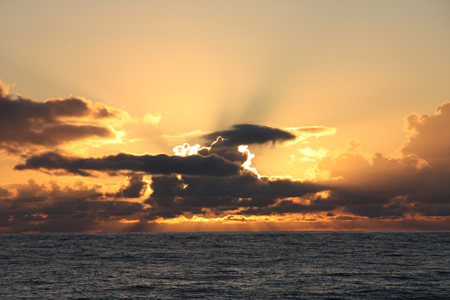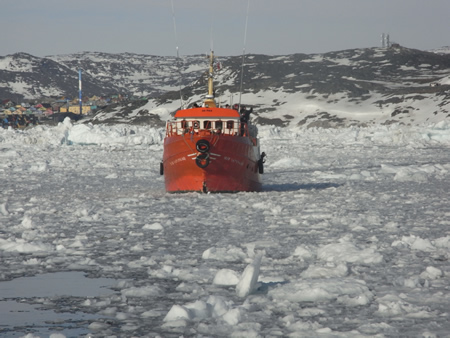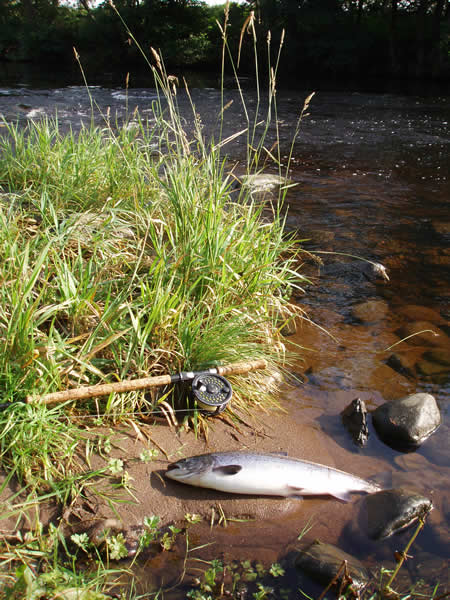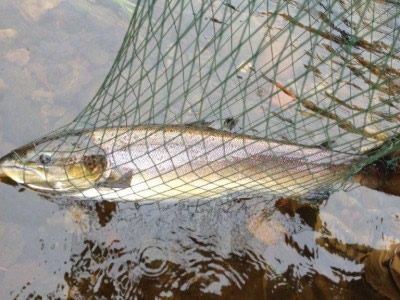These bulletin blogs represent news about Finavon and the South Esk, and my views as a riparian owner. They are not the views of any other organisation, nor are they designed to promote the interests of any individual or organisation other than Finavon Castle Water and factors affecting the fishery. Tony Andrews
The last week of August 2012 will be remembered for the big spate that overflowed the banks of the South Esk and ensured that the river stayed at a good fishing height into September. Big MSW salmon continue to arrive, with fish up to 20lbs caught on all 4 beats. In contrast to these big, healthy MSW fish we have caught a few skinny grilse, at least half of which had RVS (Red Vent Syndrome). The sharp difference in wellbeing of the MSW and One Sea Winter (grilse) fish demonstrates the effects on our returning salmon of prey species rich, as opposed to poor, areas of the ocean.
Northeast Atlantic. Great sunset, but is there anything there for our grilse to eat?
A marine biologist friend from Norway put it in very simple terms; if you draw a line North/South through the middle of Iceland it is fair to say that west of that line in the Atlantic Ocean (e.g. Irminger & Labrador Seas and the Greenland coast) salmon are likely to find an abundance of prey species, and subsequently return to their rivers of origin in good condition. Those females should ultimately deposit big healthy ova to give the next generation of salmon a good start in life.
Where some of our MSW salmon feed. 200 miles inside the arctic circle the Jacobshavn Glacier enters the sea, close to the town of Ilulisat. These prey rich coastal waters provide high quality nutrition for fish from Canada and USA, and for some European MSW salmon. It’s a long way for the fish to swim (more than 5000 miles return journey) and many mishaps can happen en route. By the time salmon from the west coast of Greenland reach Scottish rivers they are well muscled and fit, ready for the strenuous migration up its river of origin to the spawning redds, but sadly they are relatively few in numbers.
But east of that line through Iceland, salmon are likely to find a shortage of food. Many will die of starvation in the NE Atlantic and Norwegian Sea. Some will make it back to their native rivers in poor condition, with the result of producing poor quality ova. It is mainly to the northeast Atlantic Ocean where our grilse go to feed. Greenland is too far for them to go, feed and return over one sea-winter year. Hence our one sea-winter salmon return as skinny grilse. Inevitably, as with all natural things, it isn’t quite as simple as that because there are occasional patches of abundant food in the NE Atlantic. Some of our grilse are returning in reasonable condition, showing that they have found such sources of food, while others may access areas of prey abundance, for example within the Iceland shelf, but still within range of returning after one winter at sea.
A nice plump 5lbs grilse from Volcano (above). Healthy grilse like this one have been in short supply this season.
These painfully thin grilse average about 3lbs, and are unlikely to be carrying ova of good quality. Despite their poor condition, they are OK to eat, although distinctly less oily than their more fortunate fatter cousins. It is important to freeze or properly cook grilse with RVS to kill the worm that attacks the anal area of the affected fish. Using such fish for Suschi or gravadlax is not a good idea because the worms can survive these processes and attack the human body with quite serious effects. I use them well cooked to make Risotto, salmon Lasagne, or a kedgeree. Take care.
This coloured hen salmon of about 13lbs was caught on a size 12 Cascade by Andrew Robertson, and which I netted for him, in slightly amber but very clear water in the glide into Volcano. This strong and healthy fish was of course returned carefully to the river to continue her upstream journey, perhaps to spawn in one of the burns joining the main stem in Glen Clova. Such multi-sea-winter fish represent the future of salmon stocks in the South Esk, and we need to ensure that as many of them as possible reach the spawning redds in the upper catchment.
I am writing this bulletin on the 1st of September after a week of high water. The FCW catch stands at 95 salmon and grilse and 141 sea trout for the 2012 season to date. I note that beats on the North Esk are starting to catch lots of fish. The only surprise this year has been the very slow start on that river, but things should change from now to the end of the season. The seatrout runs for 2012 are now over, despite Lower Kinnaird’s 38 sea trout recorded on the Fishpal website on Thursday. If they were finnock perhaps they should be recorded as such.
The Usan netting extension. Meanwhile the Usan nets have a 14 day licence to continue fishing into September, and to catch up to 1000 salmon and grilse, but no sea trout. Setting aside the issue of politics and angry anglers, this extension to the netting season means a continuation of what we have had during August, when it appears from observation, catch returns and reports from upstream beats that there have been reasonable runs of both salmon and grilse into the river throughout the month. Let us hope that these runs of fish continue into September. The netting season will finish on 14/9/2012.
TA 1/9/2012



